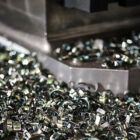Boring operations, executed to finish the holes that already exist, are of different types, depending upon the surface they are to be executed upon. Boring operations on turning machines are generally less complicated than those done on milling machines. In the former case, the boring tool is moved incrementally by the machine; and in the latter, the boring head is required to be adjusted to achieve the desires hole size. This means that the boring tools for turning can make a hole of any size, as long as the bar fits into the hole, while the boring heads for milling machines are limited to a specific range.
Basic boring bars accept carbide inserts that work well in most applications; and they’re economical too. Single-edge boring bars have a single point of contact with the workpiece, which means that is the bar is unsupported, it can lead to vibration (or chatter). This chatter is mainly the only significant drawback of using the boring bar. However, this chatter can be dealt with too.
How to eliminate chatter?
The easiest way to overcome chatter is to apply a boring bar with a larger diameter. Although being the easiest way, this isn’t always possible or practical. Hence, other measures come to play. One solution could be to work with the cutting speeds and chip loads, to alter the cutting pressure on the tool. By increasing the feed rate, the tool pressure can be increased. Similarly, by decreasing the cutting speed, the tool pressure can be increased too. Also, changing the radial DOC can put more pressure on the tool. So, one or more of these aspects can be altered and adjusted to achieve success with chatter.
Types of boring bars
Steel boring bars are the most commonly used bars because of their comparatively low cost. However, there are many other material alternatives available. For instance, heavy-metal and carbide bars can be used to fight chatter. Heavy-metal bars are made from tungsten alloys that are denser than steel and more expensive, but they can be applied at higher length-to-diameter ratios, and always work to damp vibration. In order for comparison, where steel allows a 4:1 ratio, heavy-metal bars can boost the ratio to 6:1 or even higher, with some speed-and-feed tuning. Tungsten-carbide bars can provide even higher depth-to-diameter ratios, as carbide is extremely dense, and provides superior damping, thus allowing length-to-diameter ratios in the range 8:1 or higher. Because such heavy-duty bars can be expensive, you can buy them with interchangeable heads that accept different inserts. One thing to note is that vibration-damping bars have internal mechanisms that can eliminate chatter. The internal mechanism alters the natural frequency of the bar, preventing chatter, and allowing very large length-to-diameter ratios. Some reports even suggest the ability to make cuts at 20:1!
The tools are different for milling and lathe
The tools used on a milling machine are unlike those used for a lathe; the one for the latter to be made adjustable to achieve the correct size. Boring holes on a milling machine require the use of an adjustable boring head, which only adds complexity to the setup. The boring heads shift the boring bar closer to or farther away from the axis of the hole to achieve the desired hole diameter. A large range of hole sizes can be bored with these heads as the boring bar can be mounted in several different positions. On a milling machine, more than one cutting edge can be engaged, which is unlikely in the case of a lathe. Twin boring heads can be set up in one of the two ways – first, each cutting edge is set to the same diameter that allows a fast feed rate; and second, the cutting edges are set on two different diameters, thus removing more material per pass. Twin-style heads are best suited for roughing as they are not easily adjusted when small incremental changes are necessary to the boring diameter. Thus, a finish boring head is required to make the small adjustments to the diameter, when finishing.
Boring requires the use of the right tools to achieve the desired hole characteristics of position accuracy, hole geometry, and surface finish. You thus need to choose the right boring heads and bars, which you can avail from experts like FineTech Toolings. We’re the right solution for all your hole-making applications, with our extensive line of boring heads and bars; thus making us the most diverse boring bar and precision boring head manufacturers in Bangalore.






